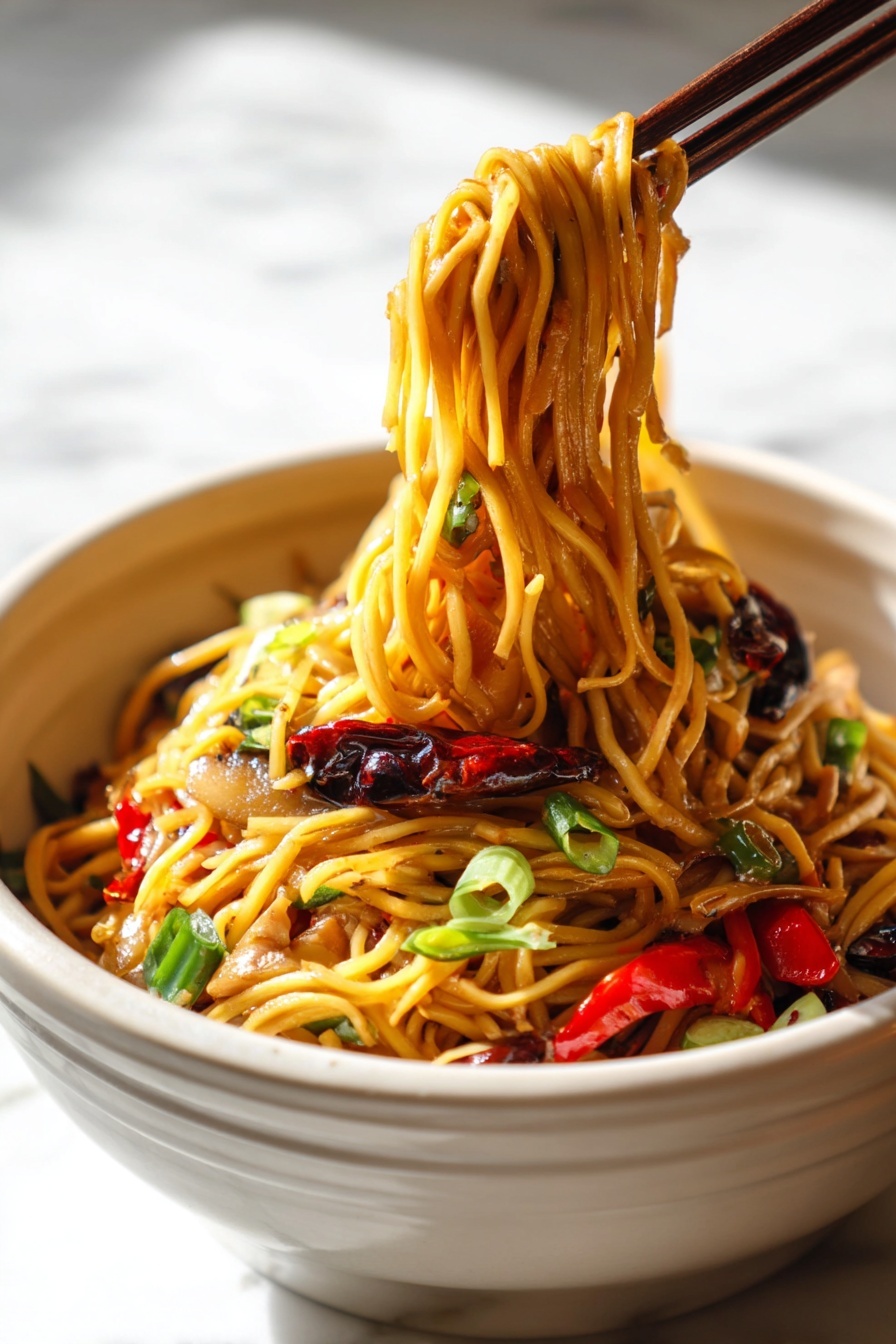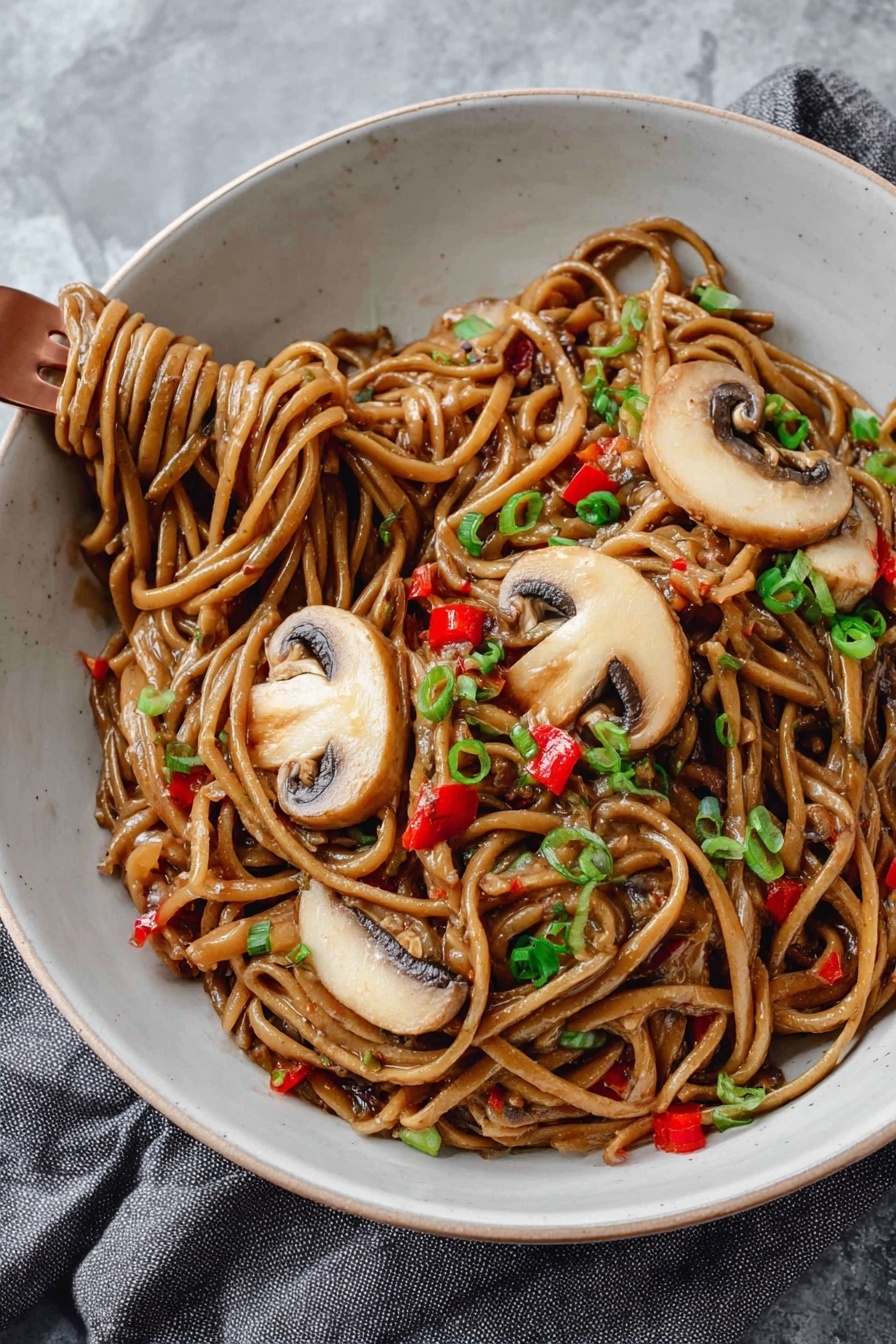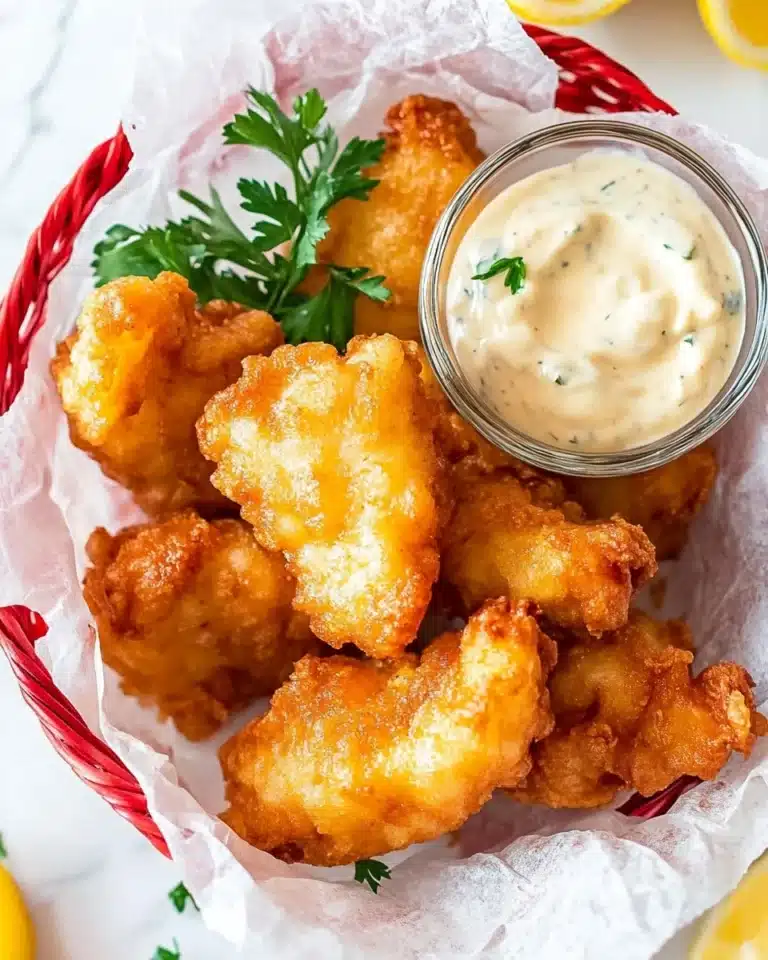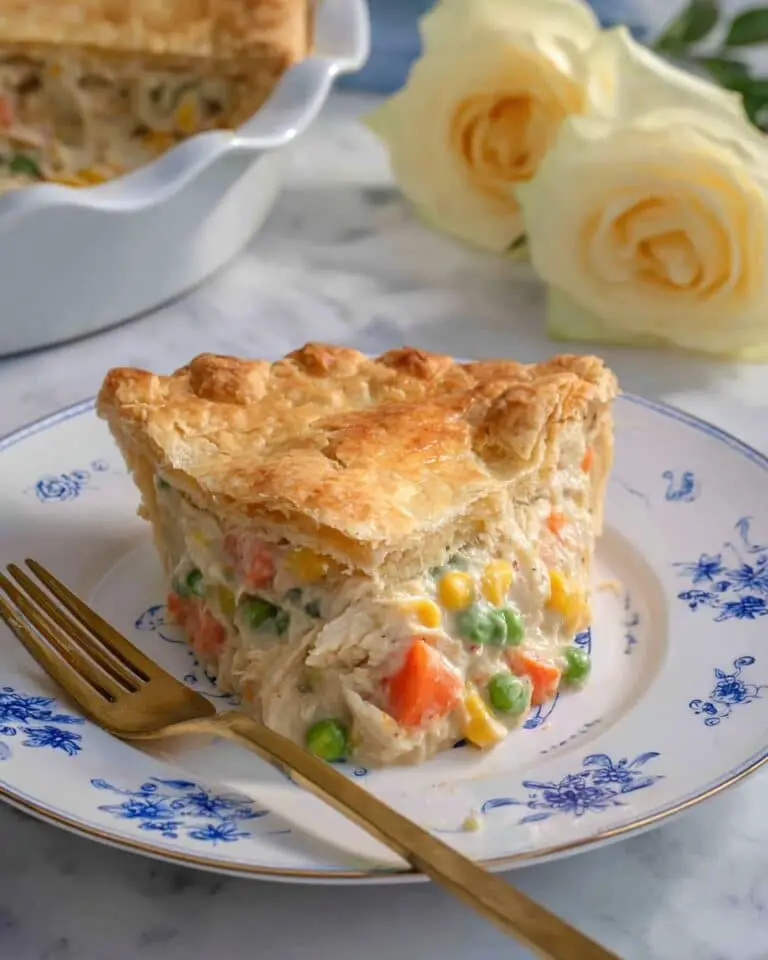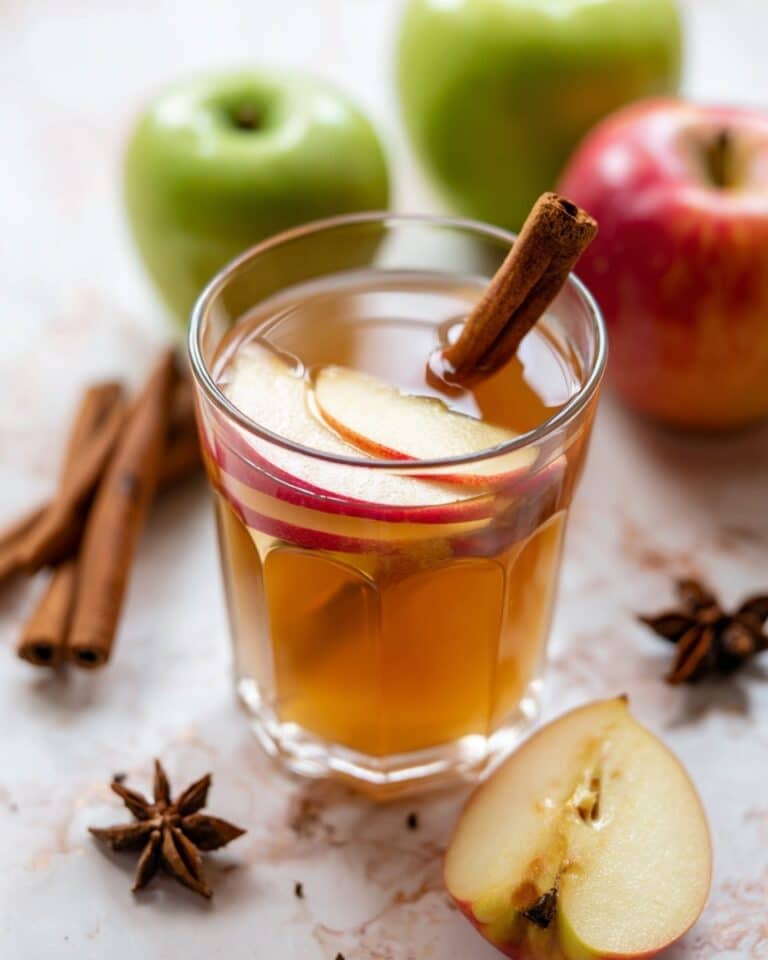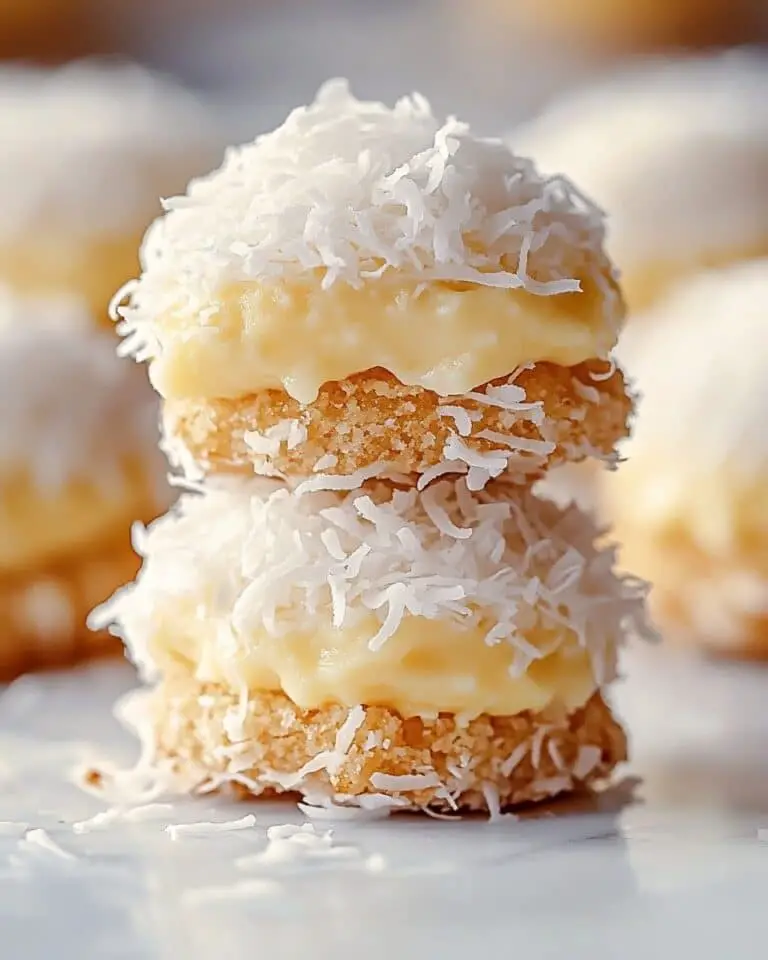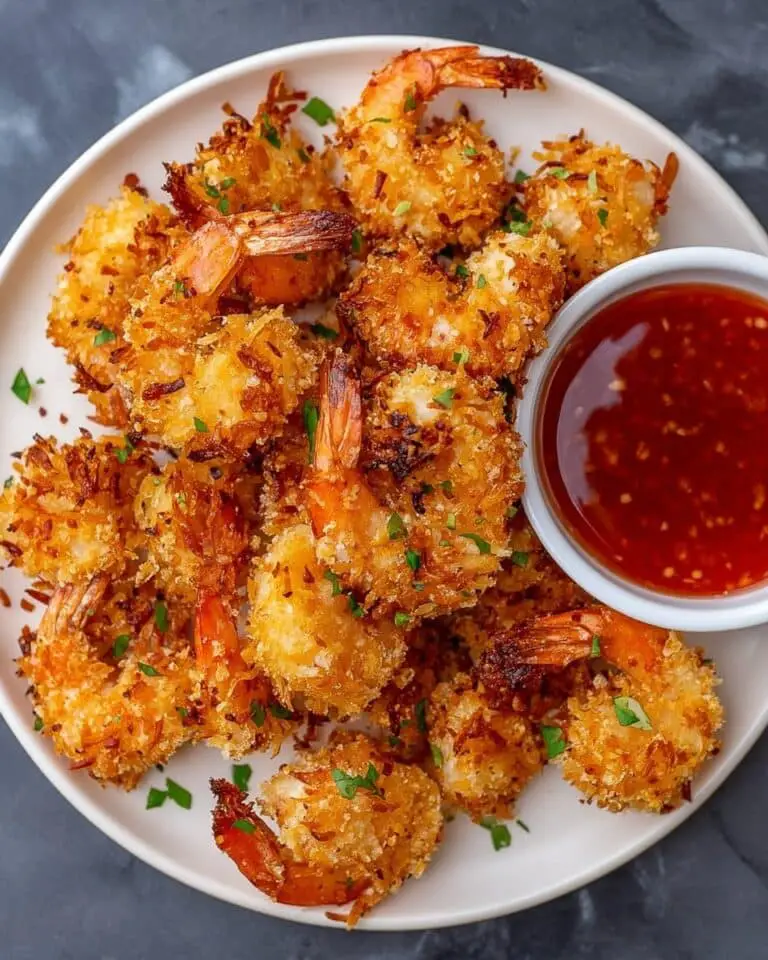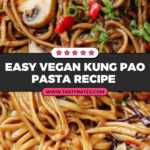If you’re looking for a fun, flavorful dinner that’s both comforting and a little adventurous, you’re going to adore this Vegan Kung Pao Pasta with Mushrooms Recipe. I stumbled upon this incredible fusion dish that brings the bold, spicy, and saucy elements of classic Kung Pao together with the familiar comfort of pasta. It’s packed with umami, a touch of heat, and that satisfying chewy texture you want in a good pasta dish. Trust me, once you try it, you’ll want to make it again and again.
Why You’ll Love This Recipe
- Flavor Explosion: The sauce is tangy, spicy, and umami-rich, making every bite exciting and satisfying.
- Easy Weeknight Meal: Ready in about 20 minutes, it’s perfect for when you want something special without the fuss.
- Totally Vegan and Flexible: Packed with mushrooms and veggies, and you can customize it with your favorite pasta or peppers.
- A Unique Fusion Dish: Combining Chinese-inspired sauces with Italian pasta creates something fresh and unexpected.
Ingredients You’ll Need
The magic of this Vegan Kung Pao Pasta with Mushrooms Recipe really sits in the sauce—rich, savory, and spicy—but the freshness of your veggies and that chewy pasta balance it perfectly. When shopping, fresh mushrooms and authentic sauces like doubanjiang can make a big difference, but I’ll share some alternatives too.

- Water: For the sauce and pasta cooking; simple but essential.
- Sugar: Balances out the spicy and sour flavors—adjust to your liking!
- Soy sauce: Adds saltiness and depth; dark mushroom soy sauce boosts color.
- Doubanjiang (chili bean paste): The heart of that spicy, fermented kick; a traditional ingredient but can be substituted with chili garlic sauce.
- Chinese black vinegar (Chinkiang vinegar): Provides that tangy, slightly sweet sourness that’s so characteristic of Kung Pao sauce.
- Shaoxing wine: Optional but adds complexity; you can use sake or skip it.
- Szechuan peppercorns: Gives that signature numbing spice—crushing fresh is best for aroma.
- Cornstarch: For thickening the sauce to that perfect clingy consistency.
- Pasta: Linguine or spaghetti works great, but use whatever you like!
- Salt & Olive oil: Basic seasoning and to prevent sticking.
- Neutral oil: For sautéing—something light like vegetable or canola oil.
- Onion and scallions: Adds sweetness and freshness; keep white and green parts separate for layering flavor.
- Mushrooms: King oyster is my favorite for meaty texture, but cremini or shiitake work beautifully too.
- Red bell pepper: For crunch and sweetness.
- Dried chilies: Optional, but I love the extra kick and smoky flavor.
- Roasted cashews or peanuts: For crunch and that nutty, roasted contrast.
- Sesame oil: A finishing drizzle to impart that toasty, nutty aroma.
Variations
This Vegan Kung Pao Pasta with Mushrooms Recipe is super forgiving, so I like to mix it up depending on what’s in my fridge or how spicy I’m feeling. Don’t hesitate to experiment and make it your own!
- Swap Mushrooms: I often sub in shiitake or even sautéed eggplant for a different texture and flavor depth.
- Add More Veggies: Bell peppers, snap peas, or baby corn up the veggie factor and add crunch.
- Adjust the Heat: Leave out dried chilies for mild or double the doubanjiang for serious spice—you’ll find your perfect heat level here.
- Use Gluten-Free Pasta: Works great if you’re avoiding gluten—just watch the cooking time to avoid mushy noodles.
How to Make Vegan Kung Pao Pasta with Mushrooms Recipe
Step 1: Prepare the Sauce and Slurry
Start by mixing together all the sauce ingredients in a bowl: water, sugar, soy sauces, doubanjiang, vinegar, Shaoxing wine, and crushed Szechuan peppercorns. I love tasting the sauce here to tweak the balance—if you want it spicier, add more doubanjiang; sweeter, add a bit more sugar. In a separate small bowl, mix the cornstarch with a tablespoon of room temp water until dissolved—this slurry will help thicken the sauce beautifully later on.
Step 2: Cook the Pasta
Bring a big pot of salted water to a boil, adding a splash of oil to keep the pasta from sticking. Cook your pasta until al dente or just chewy enough—linguine or spaghetti both work wonderfully here. Once done, reserve a bit of the pasta water and drain the rest. This reserved water is a secret weapon if you want to loosen the sauce later without watering it down.
Step 3: Sauté the Veggies and Mushrooms
Heat neutral oil in a large pan over medium heat. Toss in diced onion, the white parts of the scallions, red bell pepper, and chopped mushrooms. Cook until veggies soften and mushrooms start to brown—this adds a lovely depth of flavor. If you’re using dried chilies, toss them in now to release their smoky aroma into the oil.
Step 4: Combine Sauce and Pasta
Pour the sauce mixture into the pan and bring it to a simmer over medium heat. Once bubbling, add the cooked pasta directly into the pan. Give your cornstarch slurry a quick stir to re-mix it (it tends to settle), then pour it in. Stir everything together and let the sauce thicken, coating the pasta like a dream. Keep it cooking for a few minutes until the noodles soak up those flavors nicely.
Step 5: Finish with Nuts and Scallions
Turn off the heat and stir in roasted cashews or peanuts along with the green parts of the scallions for a fresh, crunchy contrast. Taste and adjust seasoning with salt or sugar if needed. I like to add a drizzle of sesame oil last—it lends that nutty perfume that ties everything together. Top with some extra pan-fried mushrooms for flair, and you’re ready to dig in!
Pro Tips for Making Vegan Kung Pao Pasta with Mushrooms Recipe
- Crush Fresh Szechuan Peppercorns: I learned the aroma truly pops when crushing them yourself rather than pre-ground.
- Reserve Pasta Water: This is a lifesaver to adjust sauce consistency without diluting flavor.
- Toast Nuts Separately: For maximum crunch and flavor, dry toast your cashews or peanuts before adding.
- Don’t Overcook Pasta: Leaving it slightly firm works better as it absorbs the sauce during simmering.
How to Serve Vegan Kung Pao Pasta with Mushrooms Recipe
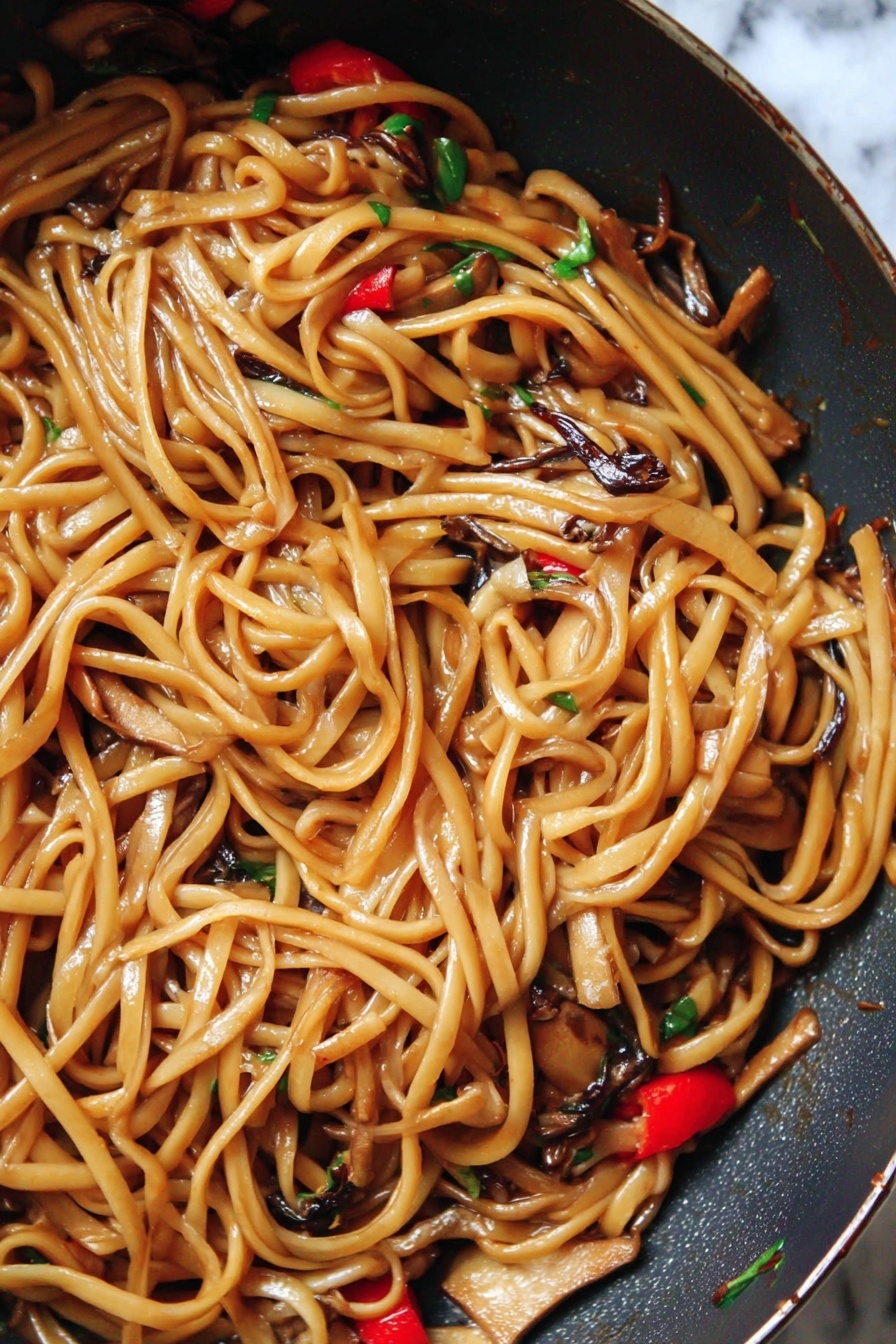
Garnishes
I always sprinkle extra green scallion tops and a handful of crunchy toasted peanuts on top just before serving—it adds texture and a vibrant pop of color. A little extra drizzle of sesame oil right before plating gives it that irresistible finish aroma.
Side Dishes
If you want to round out your meal, a simple cucumber salad with rice vinegar or quick-pickled veggies pairs wonderfully. Crispy spring rolls or steamed dumplings make it feel like a full Asian-inspired feast.
Creative Ways to Present
For a dinner party, I love serving this in large shallow bowls with a garnish of fresh cilantro and toasted sesame seeds. It’s fun to place extra chili oil and chili flakes on the side so guests can dial the heat up or down. It always impresses people because it’s unexpected yet familiar.
Make Ahead and Storage
Storing Leftovers
I keep leftovers in an airtight container in the fridge and they stay delicious for up to 3 days. Just make sure to add a splash of water or broth when reheating so the pasta doesn’t dry out since it continues to soak up sauce.
Freezing
While this dish freezes okay, I prefer fresh because the texture of the pasta and mushrooms can get a bit soft. If you freeze it, portion it out and thaw in the fridge overnight before reheating gently on the stove.
Reheating
Reheat on medium-low heat in a skillet with a splash of pasta water or vegetable broth, stirring frequently until warmed through and saucy again. Microwave reheats well too if you cover the dish and add a bit of water.
FAQs
-
Can I make this Vegan Kung Pao Pasta with Mushrooms Recipe oil-free?
Yes! You can reduce or skip oils when sautéing by using a non-stick pan and adding a little water or vegetable broth instead. The pasta will still soak up plenty of flavorful sauce.
-
What can I use instead of doubanjiang?
If doubanjiang is hard to find, you can substitute with chili garlic sauce or mix chili powder with a splash of soy sauce for a bit of fermented depth.
-
Is this recipe spicy?
It has a nice kick, but you can easily adjust the heat by reducing or omitting dried chilies and doubling or halving the doubanjiang according to your taste.
-
Can I use other types of pasta?
Absolutely! Linguine and spaghetti are my go-tos here, but feel free to try penne, fettuccine, or even gluten-free options.
Final Thoughts
I absolutely love how this Vegan Kung Pao Pasta with Mushrooms Recipe comes together — it’s fast, flavorful, and such a delightful twist on both Italian and Chinese flavors. I remember the first time I made it, I was so surprised at how much my family went crazy for it—even the pasta skeptics were convinced. It’s a handy recipe to have in your back pocket when you want to wow dinner guests or just treat yourself to something deliciously different. Give it a try—you might just find your new favorite weeknight dish!
Print
Vegan Kung Pao Pasta with Mushrooms Recipe
- Prep Time: 5 minutes
- Cook Time: 15 minutes
- Total Time: 20 minutes
- Yield: 2 servings
- Category: Main Dish
- Method: Stovetop
- Cuisine: Chinese Fusion
- Diet: Vegan
Description
A flavorful and saucy Vegan Kung Pao Pasta combining spicy, tangy, and umami notes with tender linguine, sautéed mushrooms, bell peppers, and cashews, perfect for a quick and satisfying plant-based meal.
Ingredients
Sauce Ingredients
- 1/2 cup water
- 1.5-2 tbsp sugar (adjust according to desired sweetness)
- 1 tbsp soy sauce
- 1 tsp dark mushroom soy sauce (optional for colour)
- 1 tbsp doubanjiang (or chili bean paste)
- 2 tsp Chinese black vinegar (or Chinkiang vinegar)
- 1 tbsp Shaoxing wine (or other rice wine like sake, optional)
Other Ingredients
- 1/2-1 tsp Szechuan peppercorns (crushed)
- 1/2 tbsp cornstarch
- 1 tbsp room temp. water
- 4.5 oz dry pasta of choice (linguine or spaghetti recommended)
- Salt to taste
- Olive oil
- Pasta water (as needed)
- 1 tbsp neutral oil (for cooking)
- 1/2 small onion (diced)
- 2 scallions or green onions (sliced into 2″ (5 cm) pieces, white & green parts separated)
- 1 cup chopped mushrooms (king oyster mushrooms suggested plus more for topping, optional)
- 1/2 small red bell pepper (diced)
- 3 dried chiles (arbor chiles, optional)
- Roasted cashews or peanuts (for garnish)
- Green parts of the scallion or green onions (for garnish)
- Drizzle of sesame oil
Instructions
- Prepare the Sauce: Mix all sauce ingredients together in a bowl, adjusting sweetness and spice levels to your preference for a balanced, flavorful base.
- Make Cornstarch Slurry: In a separate small bowl, combine cornstarch and 1 tablespoon of room temperature water until smooth; set aside alongside the sauce.
- Cook the Pasta: Bring a pot of salted boiling water with a splash of oil to boil, add the pasta, and cook until al dente. Drain the pasta, reserving some pasta water for later use.
- Sauté Vegetables: Heat a pan over medium heat with neutral oil. Sauté diced onion, white parts of scallions, diced red bell pepper, and chopped mushrooms until softened. Add dried chiles if using to infuse heat and flavor.
- Simmer the Sauce: Pour the prepared sauce into the pan with vegetables and allow it to simmer over medium heat until it begins to boil.
- Add Pasta: Add the cooked pasta to the pan and stir to combine thoroughly with the sauce and veggies.
- Thicken the Sauce: Stir the cornstarch slurry to re-mix and pour it over the pasta mixture. Cook over medium heat, stirring frequently until the sauce thickens and coats the pasta nicely.
- Final Seasoning and Garnish: Let the pasta absorb the sauce for a few minutes. Stir in roasted cashews or peanuts and green parts of the scallions. Adjust salt or sugar to taste. For reheating, add pasta water to loosen the sauce as needed.
- Serve: Turn off the heat, top with extra pan-fried mushrooms if desired, drizzle with sesame oil, and serve immediately while hot for best flavor and texture.
Notes
- Adjust the amount of sugar and chili bean paste to suit your preferred level of sweetness and spiciness.
- Adding a variety of mushrooms and extra vegetables enhances the dish’s texture and nutritional profile.
- For a less spicy version, omit the dried chiles or reduce doubanjiang quantity.
- Using dark mushroom soy sauce gives the dish a richer color but is optional.
- Keep some pasta water on hand to adjust sauce consistency when reheating leftovers.
Nutrition
- Serving Size: 1 serving
- Calories: 406 kcal
- Sugar: 15 g
- Sodium: 689 mg
- Fat: 9 g
- Saturated Fat: 1 g
- Unsaturated Fat: 7 g
- Trans Fat: 1 g
- Carbohydrates: 69 g
- Fiber: 5 g
- Protein: 12 g
- Cholesterol: 0 mg

